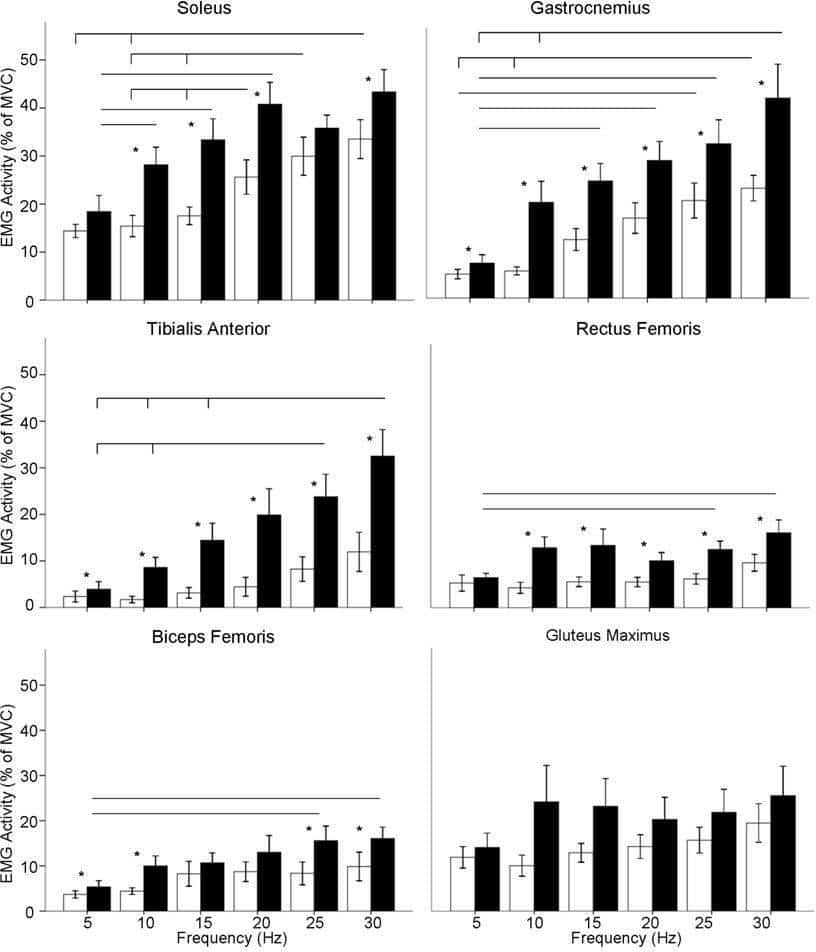There are contradictory reports about the effects of whole body vibration (WBV) on human performance, muscle strength, power, balance and bone mineral density (Bosco et al. 1999; de Ruiter et al. 2003). This may partly be due to differences in vibration protocols as the optimal settings are unclear, as are the mechanisms responsible for any vibration related neuromuscular improvements. We investigated the effect of high (5.5mm) and low (2.5mm) amplitude vibration at a range of frequencies (5-30 Hz) on muscle activity and also the effects of WBV on motoneuron excitability. Surface EMG (soleus, gastrocnemius lateralis, anterior tibialis, rectus femoris, biceps femoris and gluteus maximus) was recorded from 12 participants (aged 31 ± 12 years; height 1.76 ± 0.1 m; mass 72.7 ± 17.6 kg, mean + SD) during WBV and compared it with that recorded while performing a maximal voluntary contraction (MVC). The EMG signal was filtered to remove motion artefact at the vibration frequency and associated harmonics (Abercromby et al. 2007). Motoneuron excitability was determined in 12 participants (32 ± 9 years; 1.71 ± 0.1 m; 66.6 ± 15.2 kg) by the H :M ratio in the soleus muscle with percutaneous electrical stimulation before, immediately after and then 5, 10, 20 and 30 mins after a 5 min bout of WBV (30 Hz, 4 mm). Statistical analysis was performed using repeated measures ANOVA with post hoc analysis where appropriate. WBV increased activation levels of all muscles, most markedly in the lower leg (Fig.). Activity of soleus peaked at 43.4 ± 4.6% MVC (30 Hz, high amplitude, mean ± SE) compared with 23.1 ± 6.1 % in gluteus maximus (10 Hz high amplitude). The relationship between frequency and EMG activity appeared to be linear for all muscles other than rectus femoris and gluteus maximus which showed no effect of frequency. High amplitude WBV resulted in greater activation, with increases ranging from 1.2 – 20.6 % of MVC, however this was not always significant (p<0.05). The resting H : M (0.51 ± 0.13) was unaffected by WBV. These results indicate that WBV at high amplitudes and frequencies provides the greatest stimulus for muscle activation. The greater activity in lower leg muscles will damp vibration (Wakeling et al. 2002) and reduce that at higher segments, therefore aiding balance and stability. Whether the muscles were performing voluntary or involuntary contractions is unclear. The levels of activity would be insufficient for hypertrophy in young healthy individuals, suggesting neural mechanisms may mediate any improvements in strength and power after WBV, although they do not appear to involve changes in motoneuron excitability.
King's College London (2009) Proc Physiol Soc 14, PC5
Poster Communications: The effect of whole body vibration on muscle activity and motoneuron excitability
D. Newham1, R. Pollock1, F. C. Martin2
1. Division of Applied Biomedical Research, King's College London, London, United Kingdom. 2. Elderly Care Unit, Guys and St Thomas’ NHS Foundation Trust, London, United Kingdom.
View other abstracts by:
Figure. Mean ± SE of filtered EMG signal recorded in all muscles during WBV represented as a percentage of MVC activity. Black bars show activity during high amplitude vibration. White bars show activity during low amplitude vibration. Horizontal bars indicate significant difference in activity levels between frequencies during either high or low amplitude vibration (P<0.05). * high amplitude activity is significantly greater than low (P<0.05).
Where applicable, experiments conform with Society ethical requirements.

